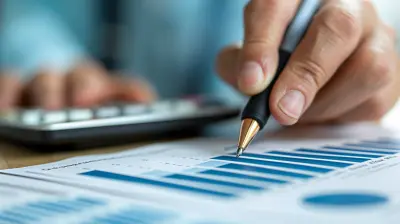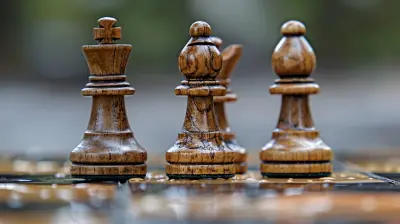The Role of Blockchain in Sustainable Energy Markets
19 December 2024
When you think about blockchain, you probably picture Bitcoin or other cryptocurrencies, right? But here's the thing—blockchain is way more than just digital money. It’s like the Swiss Army knife of technology, offering solutions to all kinds of problems across various industries. One area where it’s gaining serious traction is sustainable energy markets. Surprised? Well, buckle up because we’re about to dive into how blockchain might just be the superhero we need for a greener, more sustainable energy future. 
Why Do We Need Blockchain in the Energy Sector Anyway?
Let’s be honest—our current energy system isn’t perfect. It’s like an old, clunky flip phone in the age of shiny smartphones. Centralized grids, outdated infrastructure, high transaction costs, and reliability issues—these are just some of the hurdles.And then there’s the elephant in the room: climate change. More people are shifting to renewable energy sources like solar panels and wind turbines, but integrating these into our energy system isn’t as straightforward as flipping a switch.
This is where blockchain struts in, looking all sharp and innovative. It’s not just another tech buzzword; it’s a game-changer with the potential to revolutionize how we produce, distribute, and consume energy. 
Blockchain Basics: What Is It & How Does It Work?
First, a quick refresher for those who slept through Blockchain 101. Simply put, blockchain is a decentralized, digital ledger—kind of like a Google spreadsheet that everyone can see but can’t mess with. Transactions get recorded in “blocks” and are linked together to form a “chain.”But here’s what makes it special:
- It’s transparent - Everyone involved can see what’s happening. No shady backroom deals.
- It’s secure - Transactions are verified by a network of computers, making it super hard for hackers to tamper with.
- It’s decentralized - No single authority (like a bank or energy company) controls it. Instead, power is distributed across a network.
Got it? Cool. Now let’s talk about why this is a big deal for sustainable energy markets. 
How Blockchain is Reshaping Sustainable Energy Markets
1. Making Peer-to-Peer Energy Trading a Reality
Have you ever wondered what happens to the extra energy your solar panels generate? Right now, most of it either goes wasted or gets sold back to the grid at ridiculously low rates. Not exactly fair, right?Blockchain enables peer-to-peer (P2P) energy trading. It’s like having an energy marketplace in your neighborhood. Let’s say Sarah’s rooftop solar panels produced excess electricity today. Instead of sending it back to the grid, she can sell it directly to her neighbor Mike, who needs more power for his electric car.
No middleman. No fuss. The transaction is recorded seamlessly on the blockchain, and both parties can trust the process because it’s transparent and secure.
This P2P trading could pave the way for energy communities—neighborhoods that produce and share their own green energy. Imagine a world where you’re not just an energy consumer but an energy producer and trader too. Sounds pretty awesome, doesn’t it?
2. Streamlining Renewables Integration
Renewable energy sources are as unpredictable as the weather—which makes sense because they’re directly tied to it. Solar panels don’t work when the sun’s hiding; wind turbines don’t spin without wind. Balancing supply and demand gets tricky, especially for centralized grids.Blockchain can help by improving data management. It provides real-time, accurate data on energy production and consumption. Think of it like having a fitness tracker for your energy system—it helps grid operators understand how much power is being generated and where it’s needed.
This level of visibility makes it easier to integrate renewables into the grid without disruptions, reducing our reliance on fossil fuels.
3. Boosting Transparency in Carbon Credits
Let’s talk about carbon credits for a second. Companies buy these to offset their carbon emissions, but how do we know they’re legit? The current system is about as transparent as a foggy window.Blockchain can change this. By using it to track carbon credit transactions, you create an immutable record of who’s buying and selling what. It’s like having a digital paper trail that anyone can audit.
This added transparency could encourage more businesses to participate in carbon markets, accelerating the shift to greener practices.
4. Reducing Costs and Increasing Efficiency
Running centralized energy systems isn’t cheap. There are high administrative costs, middlemen taking their cut, and inefficiencies at every turn.With blockchain, you can cut out the middlemen and reduce overhead. Smart contracts—self-executing contracts with terms directly written into code—automate processes like billing and payments. They’re like those self-checkout machines at supermarkets but for energy transactions.
The result? Lower costs for both providers and consumers, making renewable energy more accessible to everyone.
5. Encouraging Microgrids and Energy Independence
Microgrids are small, self-sufficient energy systems that can operate independently of the central grid. They’re perfect for remote areas or places prone to natural disasters, where traditional grids might not reach or could easily fail.Blockchain makes managing microgrids a breeze. It facilitates local energy sharing and ensures everything runs smoothly without needing a central authority. Plus, in the age of rising energy prices, microgrids can empower communities to achieve energy independence.
6. Fostering Sustainable Investment
Investing in renewable energy projects often comes with high risks and complicated processes. Blockchain simplifies this through tokenization.What’s that? It’s the process of turning ownership rights into digital tokens. Imagine you want to invest in a wind farm but don’t have the funds to go all in. Tokenization allows you to buy a small stake, kind of like owning shares in a company.
This opens the door for more people to invest in green projects, encouraging faster adoption of renewable energy. 
The Challenges: Is Blockchain a Magic Wand?
Okay, let’s pump the brakes for a second. While blockchain has a lot of potential, it’s not without its challenges.Scalability issues could arise as the number of transactions increases. And let’s not forget the notorious energy consumption involved in some blockchain systems, particularly those using Proof of Work (PoW) mechanisms. It’s like trying to fight fire with fire—not exactly ideal when you’re aiming for sustainability.
The good news? Alternatives like Proof of Stake (PoS) and energy-efficient blockchain protocols are emerging. So, while there’s still work to do, the future looks promising.
What Does the Future Hold?
The role of blockchain in sustainable energy markets is only going to grow. As the technology matures and becomes more efficient, its applications will expand, making renewable energy systems smarter and more accessible.From revolutionizing how we trade energy to enhancing transparency and cutting costs, blockchain has the potential to be a cornerstone of the green energy transition. It’s not just a future possibility—it’s happening right now, and the early adopters will be the ones leading the charge.
If you’ve ever felt a twinge of eco-anxiety or wondered how you can contribute to a cleaner planet, this might be it. Sure, you might not be able to code the next big blockchain app, but supporting companies and policies pushing for these changes is a great place to start.
Final Thoughts
Blockchain and sustainable energy may seem like an odd couple at first glance, but dig a little deeper, and you’ll see they’re a match made in heaven. By addressing inefficiencies, boosting transparency, and empowering communities, blockchain could very well be the key to unlocking a greener, more resilient energy future.So, the next time someone brings up blockchain, don’t just think about Bitcoin. Think about solar panels, wind farms, and a world where everyone has access to clean, affordable energy. That’s the power of this technology—it’s not just about currency; it’s about revolution.
all images in this post were generated using AI tools
Category:
Blockchain In BusinessAuthor:

Baylor McFarlin
Discussion
rate this article
18 comments
Soraya McDougal
Blockchain has great potential to enhance transparency and efficiency in sustainable energy markets. Careful implementation is key.
March 11, 2025 at 4:19 AM

Baylor McFarlin
Thank you for your insightful comment! I completely agree—strategic implementation of blockchain is essential for unlocking its full benefits in sustainable energy.
Haze Riggs
Blockchain technology is a transformative force in sustainable energy markets, paving the way for transparency, efficiency, and trust. By harnessing its potential, we can empower communities, foster innovation, and create a greener future. Let’s embrace this change and lead the charge toward sustainable energy solutions!
February 23, 2025 at 3:58 AM

Baylor McFarlin
Thank you for your insightful comment! I completely agree that blockchain can drive transparency and efficiency in sustainable energy, empowering communities and fostering innovation for a greener future. Let's continue to explore its potential together!
Aaron Dodson
How can blockchain truly transform sustainable energy practices today?
February 11, 2025 at 8:42 PM

Baylor McFarlin
Blockchain can enhance transparency, streamline transactions, and enable peer-to-peer energy trading, thus fostering more efficient and decentralized sustainable energy practices today.
Sawyer McRae
Thank you for this insightful article on the intersection of blockchain and sustainable energy. It's encouraging to see how innovative technologies can drive efficiency and transparency in energy markets, paving the way for a more sustainable future. Looking forward to more discussions on this topic!
February 5, 2025 at 4:25 AM

Baylor McFarlin
Thank you for your thoughtful comment! I'm glad you found the article insightful. I look forward to more discussions on this exciting topic!
Skyler McRae
Blockchain empowers transparency and efficiency in sustainable energy.
February 1, 2025 at 4:51 AM

Baylor McFarlin
Thank you for your insightful comment! Indeed, blockchain technology enhances transparency and efficiency, crucial for optimizing sustainable energy markets.
Cash Sharpe
Great insights on the intersection of blockchain and sustainable energy! Your analysis highlights the potential of innovative technologies to drive positive change in energy markets. Excited to see how these advancements can promote sustainability and transparency in the industry!
January 29, 2025 at 12:54 PM

Baylor McFarlin
Thank you! I'm glad you found the insights valuable. Exciting times ahead for blockchain and sustainable energy!
Theodora Morris
Blockchain can revolutionize sustainable energy by enhancing transparency and efficiency, fostering trust and collaboration among market participants. Exciting potential ahead!
January 24, 2025 at 11:44 AM

Baylor McFarlin
Thank you for your insights! I completely agree—blockchain's ability to increase transparency and foster collaboration is indeed key to driving innovation in sustainable energy. Exciting times ahead!
Faenor Cooper
Great read! It's intriguing to see how blockchain can transform sustainable energy markets. The promise of transparency and efficiency aligns perfectly with our environmental goals. Excited to see how this technology evolves and helps us harness renewable resources more effectively. Keep up the insightful work!
January 21, 2025 at 7:20 PM

Baylor McFarlin
Thank you for your insights! I’m glad you found the article engaging. The potential of blockchain in sustainable energy is indeed exciting!
Phoenix McPhail
Thank you for this insightful article on blockchain's impact on sustainable energy markets. It's encouraging to see how innovative technologies can drive positive change in energy sustainability. I look forward to seeing further developments in this exciting intersection of technology and environmental responsibility.
January 19, 2025 at 12:37 PM

Baylor McFarlin
Thank you for your kind words! I'm glad you found the article insightful. Exciting developments lie ahead as we continue to explore blockchain's potential in sustainable energy.
Naomi McIlwain
Blockchain is revolutionizing sustainable energy markets by enhancing transparency, streamlining transactions, and empowering consumers to make conscious energy choices.
January 16, 2025 at 5:11 AM

Baylor McFarlin
Thank you for your insightful comment! Indeed, blockchain's ability to enhance transparency and empower consumers is crucial in transforming sustainable energy markets.
Astralis McCullough
Blockchain's transparency and decentralization can empower sustainable energy markets by fostering trust among participants, enhancing traceability, and enabling innovative solutions. Embracing this technology can lead to a more resilient and responsible energy future.
January 10, 2025 at 7:48 PM

Baylor McFarlin
Thank you for your insightful comment! I completely agree that blockchain's transparency and decentralization are key to building trust and resilience in sustainable energy markets. Embracing this technology can indeed pave the way for innovative solutions.
Bailey Bellamy
Great insights on how blockchain can transform sustainable energy! It's exciting to see technology paving the way for a greener future. As we embrace these innovations, let’s keep our spirits high and work together for a more sustainable planet. Every step counts! Keep up the good work!
January 6, 2025 at 4:49 AM

Baylor McFarlin
Thank you for your thoughtful comment! I completely agree—collaboration and innovation are key to a sustainable future. Let’s keep pushing forward together!
Lena McAlister
Great insights into the intersection of blockchain and sustainable energy! It's encouraging to see innovative solutions paving the way for a greener future. Keep up the fantastic work!
January 1, 2025 at 1:46 PM

Baylor McFarlin
Thank you! I'm glad you found the insights valuable. Together, we can drive positive change in sustainable energy!
Vesper McNaughton
Great article! It's encouraging to see how blockchain technology can drive innovation in sustainable energy markets. By enhancing transparency and efficiency, it has the potential to empower consumers and promote renewable resources. Excited to see how these advancements will shape a greener future for us all!
December 29, 2024 at 4:59 AM

Baylor McFarlin
Thank you for your insightful comment! I'm glad you found the article encouraging—it's exciting to see how blockchain can truly revolutionize sustainable energy.
Soren Mahoney
Great article! It’s exciting to see how blockchain technology can drive innovation and sustainability in energy markets. This powerful combination has the potential to reshape our future for the better!
December 21, 2024 at 5:16 AM

Baylor McFarlin
Thank you for your kind words! I'm glad you found the article insightful. The potential of blockchain in driving sustainable energy innovation is indeed exciting!
Matteo Collins
Ah, blockchain and sustainable energy—a match made in tech heaven! Just imagine your solar panels negotiating their own energy deals while you sip coffee. If only they could also handle laundry day! Let’s hope this combo doesn’t short-circuit our common sense!
December 20, 2024 at 9:18 PM

Baylor McFarlin
Thank you! It's exciting to envision a future where blockchain optimizes energy management and empowers smart solutions, even if laundry day remains a manual task for now!
Jackson Larsen
Blockchain is reshaping sustainable energy markets by enhancing transparency, improving efficiency, and enabling decentralized transactions. It's a game-changer that empowers both consumers and producers alike.
December 20, 2024 at 4:19 AM

Baylor McFarlin
Thank you for your insightful comment! I completely agree—blockchain's ability to enhance transparency and enable decentralized transactions is indeed transforming sustainable energy markets for the better.
Jack O'Neal
Blockchain technology offers a transparent, secure way to enhance accountability in sustainable energy markets, fostering innovation and efficiency while supporting the transition to renewable energy sources.
December 19, 2024 at 12:13 PM

Baylor McFarlin
Thank you for your insight! Blockchain indeed plays a crucial role in enhancing transparency and efficiency in sustainable energy markets, driving innovation and supporting the shift towards renewables.
MORE POSTS

Writing Persuasive Memos and Proposals for Maximum Impact

Leveraging Retirement Plans for Business Tax Advantages

Effective Delegation: A Core Skill for Project Managers

Overcoming the Fear of Failure in Entrepreneurship

The Impact of Digital Communication on Modern Business Interactions

The Role of Corporate Finance in Navigating Economic Downturns

Corporate Strategy and Employee Engagement: A Winning Formula

The Future of Corporate Finance: Trends to Watch

Key Differences Between S Corporations and LLCs for Tax Purposes

Hybrid Work Models: How Consultants Help Navigate the Shift

The Impact of Consulting on Organizational Culture